WŁADYSŁAW MIRECKI
Collection of works by Wladylaw Mirecki
Open Saturday and Sunday 10am to 5pm or by arrangement

Scroll on for images, essay and CV... |
 |
Where enquiries of prices are
made on the gallery, the work is subject to availability
and the price to change.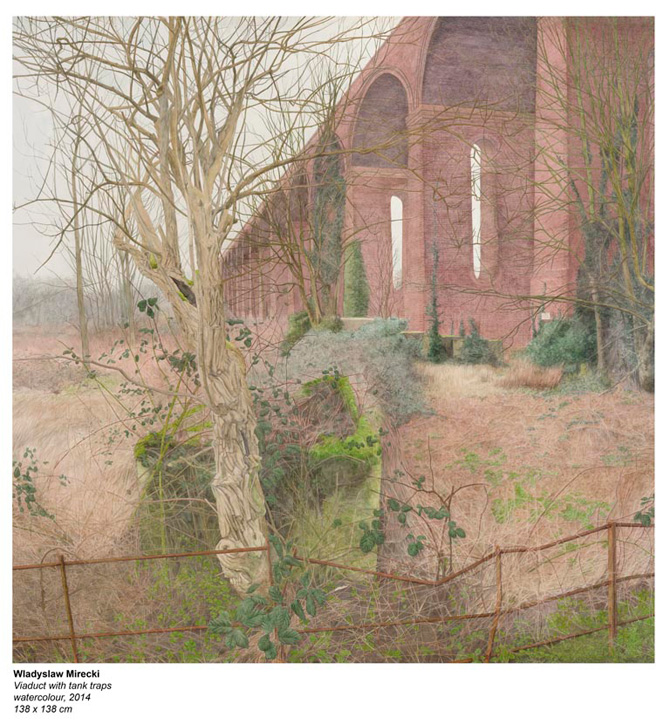
Viaduct with Tank Traps – 1st prize winner Lynn Painter-Stainers 2015
Watercolour, 2014, 138 x 138 cms £15,000
|

Barn, Bacon’s Lane 2013
watercolour
56 x 100 cms
£4,500 |

Boardwalk and Boats, Tollesbury
2013
75 x 75
£4,500 |

Colne Valley View III
2011
50 x 150
£6,000 |
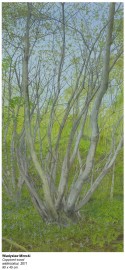
Coppiced Wood
2011
90 x 45
£3,250 |

Country Lane, Winter
2009
50 x 75
£3,000 |

Dead Christ with Three Angels
2008
140 x 86
£9,600
|
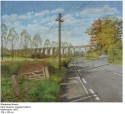
Early Autumn, Chappel Viaduct
2007
125 x 150
£15,000 |

East Cliff, Whitby II
2012
68.5 x 45
SOLD
|
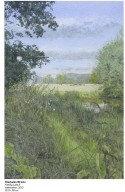
Fishing Lake II
2013
52.5 x 35
SOLD
|

Frinton Summer
2005
50 x 75
SOLD
|
|
|
|
|
|

Hawthorn
2014
75 x 50
£3,000 |

Humpty Back Bridge from the Humpty Back Bridge
2014
40 x 60
£1,925 |
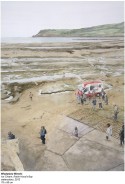
Ice Cream, Robin Hood’s Bay
2012
75.55
£3,300 |
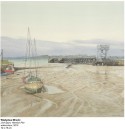
Link Span, Harwich
2013
70 x 75
£4,200
|

Mary Jane, North Norfolk
2013
40 x 60
SOLD |
|
|
|
|
|
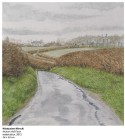
Norton Hall Farm
2007
34 x 34
Not available
|

Old Hall Farm
2013
42.5 x 100
£3,400 |

Ploughed Field with Viaduct
2010
54 x 75
£3,250 |
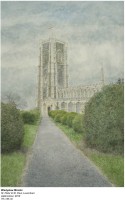
St Peter and St Paul, Lavenham
2013
75 x 50
£3,000 |

The Angler
2012
45 x 90
£3,250 |
|
|
|
|
|

The Bottom of My Garden
2004
150 x 150
£18,000 |

To the Beach, Walton
2013
75 x 50
£3,000 |

Viaduct with Poppies
2012
55 x 76
£3,350 |
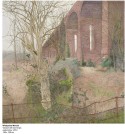
Viaduct with Tank Traps
2015
138 x 138
£15,000
|

Vineyard with Hill, Ceressou, France
2012
38 x 76
£2,300 |
|
|
|
|
|

Walton Beach
Watercolour 2013
62 x 100 cms
£4,950 |

Walton on the Naze, Cliffs
2007
50 x 135
SOLD |
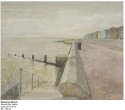
Wheelie Bin, Walton
2013
80 x 100
£6,400 |

Wood Pile, Hoe Wood 2013 85 x 71
£4,825 |
|
WŁADYSŁAW MIRECKI
1956 Born Chelmsford, Essex of Polish parentage.
He is self-taught, having painted all his life including his periods gaining his
science degree, as an industrial designer and co-proprietor of Chappel
Galleries since 1986. |
|
|
EXHIBITED |
|
|
|
New English Art Club, Mall Galleries, London
|
|
Epping Forest District Museum “Artists in Essex”
|
|
Beecroft Art Gallery, Westcliffe on Sea, Essex 31st Open Exhibition
|
|
Chappel Galleries, Essex Solo Exhibition
|
|
Foyles Art Gallery, London
|
|
Department of Transport art Competition, Mall Galleries, London
Deuxieme Salon Biennale de L’Aquarelle, Hirson, France (Chelmsford 1993)
Essex County Council, Deputy Lord Lieutenant of Essex Commission
|
|
Chappel Galleries, Essex10th Anniverary Exhibition: Solo Exhibition
|
|
Singer and Friedlander, Sunday Times Exhibition, London
Beecroft Art Gallery, Essex: Open Exhibition
|
1999 |
Jiangsu Provincial Art Gallery, Nanjing, China: Solo Exhibition
Chappel Galleries, Essex Solo Exhibition |
| 2002 |
Chappel Galleries, Essex Blyth Spirit “Walberswick Artists: 1880–2000” |
|
Chappel Galleries, Essex Solo Exhibition
WH Pattersons, London Christmas Mixed Exhibition
|
|
Royal Academy, London Summer Exhibition
WH Pattersons, London Christmas Mixed Exhibition
|
|
Chappel Galleries, Essex Solo Exhibition
|
|
Royal Watercolour Society Open Competition, Bankside Gallery, London.
Royal Institute of Painters in Watercolours, Mall Galleries, London.
Royal Society of British Artists Annual Exhibition Mall Galleries, London: Winner of the Edward Wesson Award.
Beecroft Art Gallery, Westcliffe on Sea, Essex 49th Essex Open Exhibition: Awarded Prize and Shirley Robson Bowl for the best watercolour.
Chappel Galleries, Essex ‘Southwold, the East Coast’.
Sunday Times/Kaupthing Singer & Friedlander, London: 3rd Prize Winner, The Mall Galleries, London.
Lynn Painter-Stainers, London.
Chichester Open Art Exhibition, Chichester.
Royal West of England Academy 155th Autumn Exhibition, Bristol.
New English Art Club, The Mall Galleries, London.
|
|
RWS/Sunday Times watercolour competition, Bankside Gallery, London
Lynn Painters-Stainers, London (third prize winner) |
|
Chappel Galleries, Essex Solo Exhibition
Lynn Painter-Stainers, London |
|
Royal Institute of Painters in Water Colours 198 Annual Exhibition, London
Eastern Open, King’s Lynn Arts Centre
Sunday Times Watercolour Competition 23rd Year (2nd Prize Winner), Mall Galleries, London
Duncan Campbell Fine Art, London: Solo Exhibition
|
|
Work on loan for opening of new branch of Handelsbanken, Colchester
Sunday Times Watercolour Competition in association with Smith and Williamson: The Mall Galleries, London
Discerning Eye Exhibition: The Mall Galleries, London 10-20 November
|
|
Piers Feetham Gallery, London: Solo Exhibition
Lynn Painter Stainers Exhibition, London
Chappel Galleries, Essex: Solo Exhibition
Norwich Castle Open Art Show
|
|
Chelmsford Borough Museum: Two Man Exhibition with Paul Rumsey, 9th February to 21st April.
|
|
Studio Eleven, Westcliff on Sea, Essex: ‘Kiss the Joy’ mixed exhibition.
|
|
Royal Society of British Artists, Annual Exhibition: The Mall Galleries, London.
|
|
March 1st-30th ‘…just as it is…’ Chappel Galleries, Essex: Solo Exhibition.
September Sunday Times/ Smith Williamson Watercolour Competition: The Mall Galleries, London and touring
|
|
Lyn Painter-Stainers: The Mall Galleries, London 16th to 21st Febuary 1st prize winner.
Piers Feetham Gallery, London: Solo Exhibition 19th March to 11th April.
|
|
|
COLLECTIONS |
|
|
|
|
|
Jiangsu Province Art Museum, People’s Republic of China
Jiangsu Province Department of Culture, People’s Republic of China
|
|
Chelmsford Museums, Essex
|
|
Ipswich Borough Council Museums & Galleries, Suffolk
|
|
Colchester and Ipswich Museums (on behalf of Colchester Borough Council)
|
|
|
PUBLICATIONS |
|
|
|
February Edition, Jiangsu Art Monthly
April Edition, Artists & Illustrators Magazine
|
2003 |
A Walk in the Country – 32pp Monograph |
2006 |
“Southwold: An Earthly Paradise” by Geoffrey Munn.
Władysław Mirecki at Fifty – 32pp Monograph.
BBC Television Programme: ‘Seven Man-made Wonders of the East’ interview about Chappel Viaduct, showing Mirecki’s paintings depicting the Viaduct. |
2009 |
‘On My Doorstep’: Introduction by Laura Gascoigne published by Chappel Galleries, Essex.
The Spectator “Winter Fine Arts” by Andrew Lambirth November issue.
Jackdaw Magazine “Easel Words” May/June issue.
The Artist Magazine, “Masterclass” November issue.
Pratique des Arts magazine France, December issue. |
2010 |
Duncan Campbell exhibition brochure: Introduction by Andrew Lambirth, art critic of The Spectator. |
2012 |
Jackdaw Magazine page 36: News 'That Beckam Tattoo'
'Closely Observed' Landscape - East Anglia and Beyond: Introduction by Andrew Wilton published by Piers Feetham Gallery, London.
Lynn Painter Stainers catalogue page 11 ‘Holme Valley, Yorkshire’.
‘Around and About: Introduction by David Lee editor of ‘Jackdaw’ published Chappel Galleries, Essex. |
2014 |
March 1st-30th ‘
just as it is
’ Introduction by Mark Curteis, Curator Chelmsford Museum, published by Chappel Galleries, Essex. |
2015 |
‘New Landscape Watercolours’ Introduction by Andrew Lambirth, published by Piers Feetham Gallery
|
|
I first encountered Mirecki’s work through a professional happenstance – as the newly appointed Curator of Social History and Art at Chelmsford Museum I was exploring the art in the collections and I was struck by two watercolours - Dooley’s Field and The Parapet, Chappel Viaduct 1998 both by Władysław Mirecki. My attention was drawn by the subject matter as, although I work in Chelmsford, I live on the Essex/Suffolk border and the viaduct is a prominent local landmark. I was then struck by the feel of the work, attention to detail and his honest representation of his subject matter. Władysław (or Waj to those who know him) really captures the essence and sense of place in his work - both things that I think are essential in landscape painting.
In 2013 the museum put on a major temporary exhibition of Mirecki’s work, titled Light and Dark, it juxtaposed Mirecki’s work showing light and life with more dark and gothic themes by Paul Rumsey. The exhibition enabled me to get to know Waj, see more of his work, and get an insight into the meaning and thought processes that produced the work.
It is clear that the East Anglian landscape greatly inspires him and it is present in his new exhibition in all its forms, beaches at sunset with the setting sun reflected on the foreshore (‘Lone Walker, Sunset’), desolate estuaries, woodland glades, lakes and verdant fields.
He works exclusively in water colour with a detailed technique. Self-taught, Waj makes his own rules, which is perhaps why there is so much vitality and honesty in his work. He enjoys the uneasy alliance between the natural and the man-made: a tarmac road junction turned into a beautiful composition with the sun dappled grey on tarmac in the foreground against the lush blues, greens and purples behind (‘Loveneys’). Only Waj would put in the patched tarmac: perfectly capturing present day reality for future generations as it is, because its there, but still making it beautiful. There is often obvious humour, for example, a gas holder to counterpoint the picture postcard perfection of Lavenham (‘Gas Holder, Lavenham’) or a well executed stairwell and landing representing the historic timber framed Little Hall (‘Stairwell, Little Hall Museum, Lavenham’). Indeed, the insistence of the banal and the modern as unavoidable intruders into our appreciation of nature is a hallmark of his work.
Waj deliberately uses bold elements in some of his paintings which sometimes appear not to conform to conventional principles of composition. The result initially feels uneasy to the viewer. Then you stop and look. For example, he will put a barbed wire fence in ‘Fishing Lake’ while in ‘Hogweed and willow herb’, the hogweed stands alone, forlorn, before the lush vegetation and colour of the willow herb. The hogweed initially looks out of place, not allowing the work to have that ‘picture perfect’ sense. He obviously wants to draw the viewer in by arresting their attention to what at first glance is a beautifully rendered image that somehow doesn’t seem quite right – then as the viewer stops he is drawn in to the detail, the composition, the subject matter – which reveals itself almost layer by layer. It is almost impossible to walk past one of his paintings – the viewer is compelled to stop and see what he has done and only then will the picture begin to reveal its secrets and make sense until finally, on the hogweed, you observe the small hover fly on the flower.
In water colours like ‘Link Span, Harwich Pier’ and ‘Walberswick Pier and moon’ one appreciates the subtlety of Mirecki's work; and one can almost smell and feel the sea through gently breaking waves or gentle rivulets of water on the mud flats at low tide. The seascapes, estuarine mud flats and grasses take on the warm light hues of a summer sunset or moonlit night. Mirecki captures their atmospheres beautifully, imbuing such works with a sense of peace, and inviting reflection.
Waj’s use of light is masterful. From a bright spring morning, to dusk on an estuary, you can feel the day he has painted – you know exactly the temperature, the feel of the wind, the colour of the sky. You don’t just look at his paintings – you experience them.
There are several views capturing the beauty and tranquility of Chalkney Woods, particularly known for its wood anemones, local to the Mireckis and (along with the viaduct) a common theme for inspiration in his work. In ‘Skirting the Puddle’ we see Edna (Waj’s wife and co-proprietor of the Chappel Galleries) on a bleak winter’s afternoon walking down a muddy woodland track. Here one can almost imagine being there, the smell of mud and damp decaying leaves….thinking of being home by a warm fire. The reflections in the puddle show the artist’s skill of accurate portrayal, the reflections of trees and sky perfectly rendered on the mirror surface.
Of course, no exhibition would be complete without Mirecki's beloved viaduct rising from the earth; a masterly feat of engineering and design. Surrounded by trees, lush foliage and grasses the painting eloquently expresses nature's relationship with the manmade. When it works, as it does here, it really works.
This exhibition represents the sort of quality painting one might expect from Waj. More importantly it captures and celebrates our superb English (East Anglian) countryside. Enjoy!
Dr Mark Curteis January 2014
Curator of Social History and Art, Chelmsford Museum
Much of Mirecki’s potency of image derives from the juxtaposition of man-made architecture and natural growth: a typical subject might be the River Colne in Spate. The picture’s foreground is thronged with foliage expertly painted (though thankfully not with quite the mad hallucinatory extremism of the Pre-Raphaelites), the central episode features light reflected off moving water, while trees take us into the background and the Chappel Viaduct. The accuracy is not snapshot photographic, it is a skilled recreation of a specific place at a particular time of day and season. The painting is an interpretation of a familiar landscape, an investigation into its rhythms and structures, the underlying forms which give it presence and meaning. Mirecki departs from the literal truth when it is necessary for the painting to do so, carefully heightening or moderating it. The artist’s principal work lies in making decisions about what to include and what to disregard, where to place an emphasis and where to put a counter-balance. Mirecki’s artistic transformation of his subject is so subtle and sophisticated that sometimes it goes almost unnoticed.
The coast has become another favoured subject, usually East Anglian, such as the beguilingly austere View from Clacton Pier, with its skeletal forms of wind turbines fading into the cloud-bank on the horizon. Occasionally there is no vestige of man’s impact on the environment. It is eye-opening to see a straightforward study of sea, sky and land, as put forward with luminous yet understated brilliance in West Cliff, Whitby II. Other landscapes include a vineyard in the south of France, and a couple of views of Salisbury. Mirecki strays in Constable’s footsteps over the water-meadows, places the cathedral’s spire at the top of his painting, but brings the focus in low, to the reed-fringed drainage system. This oddly serene image wakens echoes of John Nash’s painting The Moat, Grange Farm, Kimble (1922) in the Tate. Mirecki’s other Salisbury subject is a witty urban scene: the elegant spire caught this time between two red-brick council houses, and put in its place by satellite dish and double yellow lines.
As Clive James wrote recently: ‘The only way to hide the tensions of a set form is to perfect it.’ He was referring to poetry, but the same can be said of painting: only when the conflicting tensions of a landscape are resolved, can a harmonious painting result. In these beautiful new paintings, Władysław Mirecki shows us how a vision of landscape may be perfected.
Andrew Lambirth 2015
|
|
|
| |
| |
|
| |
| |
|